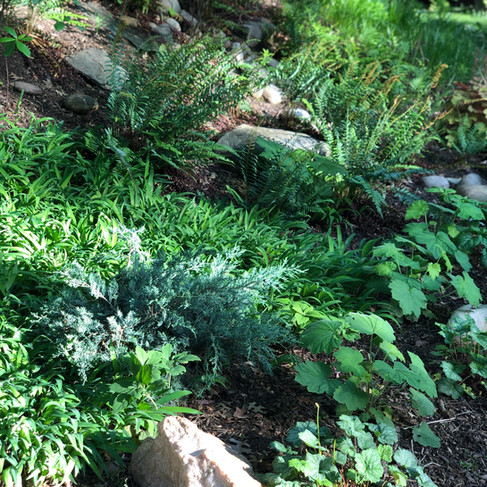Neat, loaded with eco-benefit and gorgeous.

Just take a look at this front yard garden. It is the perfect example of the beauty one can create with native plants, and this all on a slope and in shade! Seriously sublime. Why is that? There is a lot of variety in the different types of plants which experts tell us is key to supporting insects - the more variety of plants the better, they say.

So often that variety leads to gardens that are so wild looking I fear, in certain settings, they can actually deter people's interest in native plant gardens. See the tree lawn in front of my house as an example of that (working on it!).
Compare the photos of these two gardens and the differences become so clear. The tree lawn bed has loads of diversity - all herbaceous perennials that bloom from summer to fall. The plants are basically the same though - same leaf shape, color and height. The row home garden, on the other hand, mixes so many different textures, colors and shapes of foliage to create so many contrasts.
Texture Contrasts
Strappy dwarf crested iris (Iris cristata) foliage is so different than the foliage of eastern red cedar 'grey owl' (Juniperus virginiana 'Grey Owl')) and native pachysandra, Allegheny pachysandra (Pachysandra procumbens). Christmas tree fern (Polystichum acrostichoides) next to a carex (Carex) highlights both and their very different structures. A great way to test whether you have enough texture contrast is to take a photo in black and white. If the photo is still interesting, chances are you have foliage contrasts!
Color Contrasts
Light green dwarf crested iris leaves provide a bit of light green next to the darker green of Christmas fern. There is also a strong foliage shape contrast here as well. Christmas ferns also are so different from the leaf shape of heuchera (Heuchera) Allegheny pachysandra. While we all acknowledge scientists tell us cultivars like this heuchera 'caramel' (Heuchera 'caramel'), where the color of the leaves is changed from the straight species, aren't as ecologically valuable, placing a few here and there can really make a garden! The vast majority of plants in this garden are straight species plants.
Shape Contrasts
The newly emerging foliage of gayfeather (Liatris spicata) is totally different than that of the nearby ferns. To the right, all the shapes contrast!

Height
Most plants in this garden are ground covers or shorter perennials. A handful of shrubs -- two summer sweet clethra (Clethra alnifolia) and a red twig dogwood (Cornus sericea) -- provide height and bridge the difference between the shorter plants and the original, very old cherry tree that still stands center in this garden. If there were no bridge between the two or it was just a garden of low plants, it wouldn't have nearly the impact it does. Variety of height is key.
The Details
Small touches add enormously to small gardens. Alice, the gardener here, is truly an artist. Adding details like allowing dwarf crested iris to soften the edge of the steps, centering a birdbath (made by Alice!), allowing moss to form a lush carpet near a pile of stones and the shape of the hollowed out log, fill the garden with intention and care. There are also bare spots here and there, allowing your eye to rest, as garden designers would say.
Amazing. If you have a shady slope, Alice's garden provides big ideas in a small space!
Happy gardening.































Comentarios